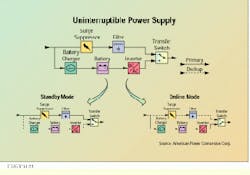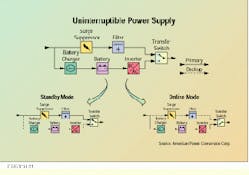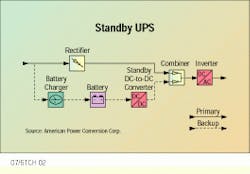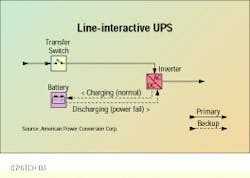Lynn Haber
Uninterruptible power supplies (UPSs) have come a long way in the 30-year history of the technology. A UPS is not just an insurance policy or protection for your computer and data; it has evolved into an active tool for intelligent power-supply management.
The fundamental objective of UPS systems has remained the same: They protect against conditions such as brownouts, blackouts, spikes, surges and noise. The technology, however, has changed substantially; UPS systems have become less expensive, smaller, more reliable and easier to operate.
This change results, in part, from the differing conditions under which power-protection equipment must now operate. Critical data used to reside on an organization`s mainframe computer, but today`s distributed computer architectures mean that this data sits on a variety of devices, including PCs, servers, local area networks, minicomputers, gateways, routers and telephone switches. Large UPS systems used to sit inside an equipment room and protect the host computer; now, UPS systems reside on the desktop or underneath it, or they can be found in the departmental wiring closet.
A UPS is a necessity in today`s computing environment, where data loss and computer downtime are unacceptable. Power protection, then, has become intertwined with computer systems, making a UPS part of every corporate computing strategy.
Given the fact that computer systems have rapidly become mission-critical to business enterprises, it is not surprising that the UPS market was valued at $1.13 billion in 1995. Growth is expected to continue at an annual rate of 12% through the year 2000, according to market-research company Venture Development Corp. (VDC, Natick, MA).
VDC estimates that 10 vendors--American Power Conversion Corp., Exide Electronics, Best Power, Liebert Corp., Deltec Electronics Corp., Tripp Lite, Toshiba International, Square D-EPE, Piller and Acme Electric--garner more than 80% of the UPS market. In addition, the UPS industry is experiencing mergers and acquisitions that are shrinking the number of suppliers in the marketplace. "The trend among manufacturers is to carry a broad range of products for one-stop shopping," says David Wyman, director of power protection at VDC.
UPS technology evolves
Technical innovation has enabled UPS systems to become smaller, lighter, quieter, more user-friendly products. The latest products are known as micro UPSs, which deliver up to 3 kilovolt-amperes, or 3000 volt-amperes, of power protection.
Semiconductor technology is at the heart of UPS products. Today`s transistors have replaced yesterday`s silicon control rectifiers, resulting in smaller packaging, switching at higher frequencies for quieter operation, higher efficiency and frequency, and voltage regulation needed to deal with nonlinear loads.
Changes over the last five years have occurred in manufacturing and packaging, says Tom Pfendler, manager of strategic marketing at Liebert Corp. (Columbus, OH). By consolidating components on a single board versus multiple boards, and using surface-mount technology, manufacturers have been able to turn out smaller devices. Having fewer components means less heat generation and increased reliability.
There have also been recent improvements in batteries. Twenty years ago, UPS systems used wet-cell batteries that were external to the UPS unit and mounted on racks in a special room. Today, the battery is a more benign device and is packaged inside the unit, eliminating the need for extra floor space. "Sealed and valve-regulated technology has taken over," says Pfendler.
Batteries are also a disposable item. People used to expect 15 to 20 years from a battery, but now batteries are replaced approximately every five years. They are also less expensive and easier to install than earlier versions.
The state of the art in UPS technology is modular design combining separate components, hot-swap batteries and hot-swap electronic parts. "In general, we`re seeing UPS technology mirror technology advancements in the server area," says Jim Hamann, business unit leader for the server and network solutions group at American Power Conversion Corp. (West Kingston, RI). "It is offering more fault-tolerance, higher availability, and better price and performance."
American Power Conversion has recently introduced the SmartUPS, which features user-replaceable batteries and internal management capability. The unit accepts management cards based on the industry-standard Simple Network Management Protocol. The addition of intelligence and communications capabilities to the UPS unit enables it to offer active power-supply management. Units with built-in intelligence can operate over the network, accept commands and alert users when there are power problems. "Some units can even page someone when there`s a problem," says Doug Milner, director of partner marketing at Exide Electronics Group Inc. (Raleigh, NC).
Cabling installation and maintenance companies, such as Corporate Communications Inc. (Smithfield, RI), have seen a change over the last two to three years in UPS technology, as well as increased customer interest in UPS systems. "We`re finding more people using UPS systems as electrical problems become more numerous," says David Nelson, a consultant for the company.
Nelson, an American Power Conversion business partner, is particularly impressed with newer, intelligent UPS technology that monitors and tests the network for power problems. "Not only has the technology improved, but costs have come down," he adds.
Several types of devices
The three main categories of UPS systems are online, standby and line-interactive. Systems in all three categories are designed to improve the quality of alternating-current (AC) power and to provide uninterrupted operation of AC-powered equipment. To do this, the UPS takes in AC power of normal quality from the utility and provides two enhancements: power-quality improvement and a redundant (or back-up) power source.
Online: These units are high-performance, high-priced UPS systems for applications where precise voltage and frequency regulation under all operating conditions is required. Online systems offer continuous correction--constant regulation, along with the best power quality and performance. According to American Power Conversion, because there is no switching in online UPS designs, there is no transfer time between AC input and UPS power during a power failure. However, there is a tradeoff: With online systems, the operating cost is higher because of lower efficiency.
Standby: These devices only provide outage protection; during normal operation, the unit "stands by." Power goes through the unit, but there is no line conditioning and no correction for voltage fluctuations. However, when the standby UPS senses an outage, it switches to backup power provided by the battery and inverter. This results in a transfer time usually measured in milliseconds, which a desktop PC is unlikely to notice. A low-cost power-management solution, a standby system gives users time to back up their computers.
Line-interactive: This UPS is a hybrid design that combines standby and online technologies. The battery-to-AC power converter (or inverter) is always connected to the output of the UPS. According to American Power Conversion, battery charging is done by operating the inverter in reverse during times when input AC power is normal. When input power fails, the transfer switch opens and the power flow is from the battery to the UPS output. The line-interactive unit provides filtering and voltage regulation. Such UPS systems are not as precise as online products, but they are less expensive and more efficient.
The application for which each type of UPS is best suited centers on its power capacity. For example, PC power capacity is between 140 and 160 watts. Power capacity for servers is 400 to 600W, while minicomputers run 2000 to 3000W. There is a trend toward covering several servers or other devices with one UPS, so the power rating required might be a multiple of the wattage of a single unit.
A second concern in choosing a UPS is the criticality of the device being protected. For example, if your aim is to protect three Unix file servers that have to be up 24 hours a day, the best fit is an online design. Desktop users, on the other hand, may only need standby technology.
Exide`s Milner says that online UPS products are popular for devices such as servers, while standby units are more popular for the desktop. Line-interactive systems are gaining market share and are somewhere in the middle of the other two types of UPS units.
APC`s Hamann adds that 80% of all servers are protected with UPSs, while desktop penetration is only 1% or 2%.
Broader product selection has done much to encourage organizations to deploy UPS systems. "With smaller units available, companies that weren`t interested in spending a lot of money are now buying, protecting servers and other computing devices," says Bruce Phillips, senior project manager at Valley Communications Inc. (Fremont, CA).
Although Valley Communications is a low-voltage installer and doesn`t put in UPS systems, it recommends UPS technology to customers when it is designing network and cabling systems. "It makes sense to buy UPS systems to ensure data protection," Phillips says. "There are so many different product sizes and costs for the units that customers can easily find the right fit for their needs."
How often organizations actually need power protection depends on their geographic location and the power source they use. However, UPS protection is a lot like sky-diving: You don`t want to get caught without the protection of a correctly packed parachute that one critical time.
Power anomalies
Many power anomalies are caused by thunderstorms, lightning or flooding. Lightning activity, for instance, is prominent in states like Florida, where organizations can experience daily power outages. The quality of a building`s wiring can also lead to outages. It is more likely, though, that power-quality problems reside with the power source. Utilities may not always be able to provide clean, consistent power.
The effects of power-quality problems can range from keyboard lockups and hardware degradation to computer downtime, data loss or burnt-out motherboards. Manufacturers claim that the cost of an uninterruptible power supply can be equated to the cost of doing business--and that you get what you pay for. Buyers should first determine their application and then compare price, performance (for example, efficiency, voltage requirements and frequency regulation) and other factors such as battery life.
Prices vary according to system size:
Micro UPSs, for example, are used with a PC or other desktop device. The cost of 120V of protection is approximately $100. For the server environment, which still operates at 120V, expect to pay $500 to $1500.
A small UPS, operating at 120 to 240V, costs $4000 to $10,000.
A medium-sized UPS, intended for a midrange computer or small mainframe, takes 120 to 208V of three-phase power and costs $20,000 to $100,000.
Large UPSs can cover an entire data center or computer facility and may cost millions of dollars per installation.
Low-voltage cabling contractors may not currently handle UPS installations, but the trend of power-protection products is toward modular, plug-and-play designs, making installation easier. Electrical contractors install medium- to large-sized UPS systems because of their requirements for special circuits and circuit breakers.
(Even if you don`t install UPSs, Liebert`s Pfendler recommends that you don`t run communications cables with power circuits. Pulling both cable types in a single conduit can expose the communications lines to noise.)
Careful cable management also makes sense. Liebert, for example, integrates cooling and power protection in a single cabinet. These devices, however, are often located in a wiring closet with a media access unit, hub or router, which may need separate cooling.
Power-protection products can either be stacked or racked. According to Corporate Communications`s Nelson, customers generally prefer rack-mount UPS systems. Rack-mounting, when not used to protect dedicated systems, permits easy access and simplified management.
Resellers can purchase UPSs from a number of sources, including distributors, mail-order companies or, in the case of micro UPSs, at local computer stores.
Overloading a device is the biggest power-protection problem, so sizing a UPS is critical for optimum performance. "People don`t recognize that load is an important factor in UPS selection," says Hamann. "It can be confusing," he adds. "Systems are rated by watts and volt-amps. You want to make sure you get the run-time you`re looking for."
To size a UPS, look for the power requirements of the equipment to be protected. If you are trying to protect several pieces of equipment, add up the numbers. Consult the equipment manufacturer`s product specifications for the information if it cannot be found on the equipment itself. UPS manufacturers offer a sizing guide and toll-free telephone number to call for support.
The basic uninterruptible power supply is the online device, which operates in both online and standby modes.
The standby uninterruptible power supply is characterized by a transfer time when switching from primary to backup power. This is a standby online hybrid UPS.
076TCH03
The line-interactive uninterruptible power supply is a hybrid device combining online and standby technologies.



